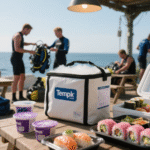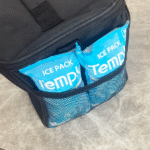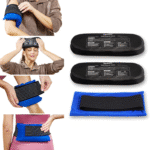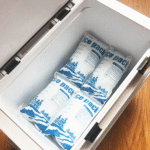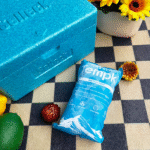Maintaining vaccine potency depends on cold chain vaccine storage and handling. في 2025, immunization programs continue to expand, and the market for vaccine shippers alone is projected to grow from دولار أمريكي 1.5 مليار في 2024 إلى USD 3.5 مليار من قبل 2033. Yet one out of range temperature excursion can destroy a vial. Most vaccines require refrigerated temperatures between 2 درجة مئوية و 8 درجة مئوية, some freeze below -15 درجة مئوية and a few mRNA formulations need ultra cold storage as low as –90 °C. Proper handling, monitoring and contingency planning are essential. This guide demystifies the process, focusing on equipment, procedures and innovations that keep vaccines safe.
Temperature Ranges: What are the recommended temperature ranges for vaccine storage, and why is a narrow range critical?
Equipment Choices: How do you choose refrigerators, freezers and ultra cold units suited to different vaccine types?
يراقب & SOPS: Which devices and procedures ensure temperatures remain in range, and how should you respond when they don’t?
تمرين & Coordination: Who is responsible for cold chain management, and what training and standard operating procedures (SOPS) are required?
الاتجاهات الناشئة: What innovations, market dynamics and regulatory changes in 2025 influence vaccine cold chain management?
نصائح عملية & الأسئلة الشائعة: How can you apply best practices, avoid pitfalls and protect your inventory during an emergency?
What Are the Recommended Temperature Ranges and Why Do They Matter?
Vaccines are biological products that lose potency outside their prescribed temperature ranges. Standard refrigerators must maintain 2 درجة مئوية -8 درجة مئوية (36 درجة فهرنهايت – 46 درجة فهرنهايت). Frozen vaccines like varicella and some COVID 19 formulations require -50 درجة مئوية إلى -15 درجة مئوية (–58 °F to 5 ° f), while ultra cold mRNA vaccines are stored between –90 °C and –60 °C (–130 °F to –76 °F). Exposure above or below these ranges can degrade proteins, destabilize lipids and render the vaccine ineffective. Overheating is like leaving a cake out in the sun—essential ingredients break down; freezing certain vaccines forms ice crystals that damage molecular structures.
Maintaining these ranges is not optional. The CDC recommends recording minimum and maximum temperatures at least twice daily and using calibrated digital data loggers (DDLs) to track temperatures continuously. في 2025, some vaccine vials (such as mRNA COVID 19 vaccines) can be transferred from ultra cold to refrigerated conditions for limited periods; على سبيل المثال, the Pfizer BioNTech Comirnaty vaccine may be stored between 2 درجة مئوية و 8 درجة مئوية لمدة تصل إلى 10 أسابيع after thawing. Adhering to these guidelines prevents costly revaccination and protects public trust.
Choosing Appropriate Storage Equipment
Selecting the right storage unit depends on the vaccine’s temperature requirements and facility capacity. Purpose built, pharmaceutical grade refrigerators and freezers are preferred; if unavailable, stand alone household units can be used, but combination refrigerator/freezers are not recommended. Dorm style units with a single exterior door should never be used because they pose a significant risk of freezing vaccines. Each storage unit should have enough space to hold the largest expected inventory (على سبيل المثال, during flu season) without crowding.
| Equipment Type | نطاق درجة الحرارة الموصى بها | Vaccines Stored | الأهمية العملية |
| Pharmaceutical Grade Refrigerator | 2 درجة مئوية -8 درجة مئوية (36 درجة فهرنهايت – 46 درجة فهرنهايت) | Influenza, DTaP, HPV, MMR and most routine vaccines | Stable temperatures protect potency; a stand alone unit prevents freezing from a shared freezer compartment |
| Medical Freezer | –50 °C– –15 °C (–58 °F–5 °F) | Varicella, mpox (Jynneos) and some COVID 19 vaccines like Moderna Spikevax | Separate freezer prevents warm air from circulating onto refrigerated vaccines; manual defrost units require regular maintenance |
| Ultra Cold Freezer | –90 درجة مئوية – –60 درجة مئوية (–130 °F– –76 °F) | لقاحات مرنا (على سبيل المثال, Pfizer BioNTech Comirnaty), advanced biologics | Specialized units with alarms and backup power; vital for high value biologics |
نصائح ونصيحة عملية
Use purpose built units: Choose pharmaceutical grade refrigerators and freezers; avoid dormitory or “bar” units that risk freezing vaccines.
Set thermostats at mid range: Adjust to approximately 5 °C for refrigerators and –25 °C for freezers to minimize fluctuations
Organize inventory: Keep vaccines in their original boxes to protect from light and track expiry dates; arrange by type and expiration to practice first expired, أولًا (FEFO).
Avoid overcrowding: Allow space for air circulation by storing vaccines in the center of shelves and using water bottles to help stabilize temperature.
التسمية بوضوح: Designate shelves for refrigerated and frozen vaccines; do not store diluents or food in vaccine units.
مثال العالم الحقيقي: في 2024 a clinic in upstate New York avoided wasting أكثر من دولار أمريكي 20,000 worth of vaccines when a freezer failed. Staff had a backup unit, maintained documentation showing the backup could maintain 2 درجة مئوية -8 درجة مئوية, and executed their emergency plan to transfer the inventory quickly.
How Should You Monitor and Manage Vaccine Cold Chains?
Continuous monitoring and clear procedures are the heart of vaccine cold chain management. The CDC requires each storage unit to be equipped with a مسجل البيانات الرقمية (DDL) that records temperatures at least every 30 دقائق. A DDL must have a buffered temperature probe, out of range alarm, low battery indicator, display of current, minimum and maximum temperatures, and an uncertainty of ±0.5 °C. Facilities should also maintain backup DDLs and ensure calibration certificates are current.
Temperature data should be reviewed and downloaded at least every two weeks and whenever an excursion occurs. Documentation should be kept for at least three years to comply with audit requirements. Staff must check and record min/max temperatures at the start of each workday. If a device doesn’t display min/max readings, temperatures must be checked at least twice daily. Regular calibration ensures accuracy.
Developing Standard Operating Procedures and Training Staff
Every facility should create and maintain written إجراءات التشغيل القياسية (SOPS) covering routine storage and handling, emergency procedures and general information. SOPs should be updated annually by the vaccine coordinator and reviewed by staff. Training is critical: all staff who handle vaccines must receive orientation and annual refresher training; additional training is required when new vaccines are introduced or guidelines change.
المعينة منسق اللقاحات and alternate oversee ordering, receiving and monitoring vaccines; they ensure temperature logs are recorded, rotate stock, respond to excursions and manage transport. Good procedures emphasise verifying packaging upon delivery, checking temperature indicators and reporting discrepancies.
| DDL Feature | لماذا يهم | Benefit to Your Facility |
| Buffered probe | Measures liquid temperature rather than air, reflecting true vaccine temperature | Prevents false alarms when doors open; protects vaccines from unnecessary transfers |
| Alarm for out of range temperatures | Alerts staff immediately when temperatures deviate from the safe range | Enables rapid corrective action to save vaccines |
| Programmable logging interval | Allows temperature recording at least every 30 دقائق | Provides detailed trend data to analyse fluctuations and comply with regulations |
| Calibration certificate | Confirms device accuracy with uncertainty ±0.5 °C | Ensures audit readiness and supports quality assurance |
| Downloadable data & الاتصال | Provides remote access and long term analysis | Enables predictive maintenance and easier reporting |
الاستعداد للطوارئ: Responding to Excursions
Despite best efforts, equipment failures or power outages can happen. The CDC advises facilities to have contingency plans that include backup power (على سبيل المثال, generators capable of maintaining cold storage for 72 ساعات) and an alternative storage facility within the required temperature range. Transport plans should outline how to pack vaccines with conditioned water bottles or cold packs and separate refrigerated and frozen vaccines. Maintain a contact list for building management, security and health departments. Vaccines exposed to questionable temperatures should be labeled “Do NOT Use” until viability is confirmed.
السيناريو العملي: A community pharmacy noticed a DDL alarm at 6 AM. Staff recorded min/max temperatures (34 درجة فهرنهايت و 39 ° f) and discovered that the refrigerator door was slightly ajar overnight. Because they documented temperatures and responded promptly, the vaccines remained within range and were not wasted.
Who Is Responsible for Cold Chain Management?
Accountability is vital for protecting vaccines. A primary vaccine coordinator and an alternate must be appointed to ensure proper storage and handling. Coordinators are responsible for ordering vaccines, organising and rotating stock, setting up temperature monitoring devices and responding to excursions. They must also develop and update SOPs, train staff and oversee emergency preparations.
Facilities must provide regular training so that all staff understand procedures and know where to find SOPs. Training should occur during new employee orientation, annually for all staff involved in immunisation activities and whenever new vaccines or updated recommendations are introduced. This ensures that everyone knows how to read DDL alarms, record temperatures and implement contingency plans.
Internal Audits and Continuous Improvement
Periodic internal audits help identify gaps and opportunities for improvement. Review temperature logs for trends, check calibration dates, verify that staff documentation is complete and test emergency procedures. Evaluate the performance of storage units, including door seals, temperature stability and alarm functionality. Continuous improvement fosters resilience and reduces waste.
What Innovations and Trends Are Shaping Vaccine Cold Chain Management in 2025?
Rapid technological advances and market dynamics are transforming vaccine cold chains. The vaccine shippers market is forecast to grow at a CAGR of around 10 %, rising from دولار أمريكي 1.5 مليار في 2024 إلى USD 3.5 مليار من قبل 2033. Demand is fueled by rising vaccine production, new biologics and global immunization programs. North America currently holds 40 % of the vaccine shippers market, with Asia Pacific growing fastest at a 10 % CAGR, reflecting increasing healthcare investment. Passive vaccine shippers dominate with a 60 % الحصة السوقية, while reusable units are the fastest growing sub segment due to sustainability goals.
التقنيات الناشئة
الذكاء الاصطناعي والتحليلات التنبؤية: Modern DDLs and cloud platforms use machine learning to identify patterns in temperature data and predict equipment failures, تمكين الصيانة الاستباقية. AI also supports route optimization and real time visibility across the supply chain.
High Performance Insulated Packaging: Passive shippers with advanced phase change materials and vacuum insulation can maintain ultra cold temperatures for 96 hours or longer without dry ice, الحد من البصمة الكربونية. Reusable shippers help reduce waste and lower cost of ownership.
Solar Powered and Off Grid Refrigerators: Solar direct drive fridges and vaccine coolers are increasingly adopted in remote areas to ensure reliable cold storage where electricity is unreliable.
Digital Traceability and Blockchain: Blockchain and connected devices create immutable records of temperature data and chain of custody, enhancing compliance with Good Distribution Practices and fostering trust among stakeholders.
IoT enabled Transport: GPS enabled temperature sensors track shipments in real time, sending alerts when thresholds are exceeded. These systems integrate with logistics platforms to provide a holistic view of the cold chain and facilitate rapid interventions.
نمو السوق والاتجاهات الإقليمية
| مؤشر | Value and Trend | ضمنا |
| Market Size (Vaccine Shippers) | دولار أمريكي 1.5 B in 2024, projected to USD 3.5 ب بواسطة 2033 | Signals a growing need for specialised packaging and transport solutions |
| Industry Value | CDC projects the vaccine storage and transportation industry to reach دولار أمريكي 2.4 ب بواسطة 2025 | Highlights investment in infrastructure and technology |
| Dominant Region | أمريكا الشمالية تحمل 40 % الحصة السوقية; أوروبا 30 %; آسيا والمحيط الهادئ 20 % | Shows developed markets lead but Asia is catching up |
| المنطقة الأسرع نموا | آسيا والمحيط الهادئ, مع 10 % CAGR من 2023 ل 2028 | Reflects expanding vaccination programs and logistic investments |
| Top Sub Segment | Passive vaccine shippers hold 60 % الحصة السوقية; reusable units are growing fastest | Indicates sustainability initiatives and cost savings |
Real World Innovation Example
During the initial rollout of mRNA COVID 19 vaccines, limited access to ultra cold freezers led to the development of specialized shipping boxes filled with dry ice. These boxes allowed vaccines requiring -70 درجة مئوية storage to be transported globally without dedicated freezers, demonstrating how packaging innovation can overcome infrastructure gaps.
2025 Developments and Trends in Vaccine Cold Chain Storage and Handling
في 2025, vaccine cold chain management continues to evolve as new technologies and regulations take hold. ممارسة توزيع جيدة (الناتج المحلي الإجمالي) المبادئ التوجيهية now require validated equipment, temperature mapping and robust documentation for pharmaceutical logistics. The FDA’s cGMP regulations emphasize proper storage and distribution procedures. These rules underline the need for continuous monitoring and quality assurance throughout the supply chain.
Vaccine programs in low and middle income countries are expanding, creating demand for sustainable off grid refrigeration and cost effective passive shippers. Investment in digital health infrastructure means more facilities integrate cloud connected DDLs and remote management tools. With the growth of personalized medicine and gene therapies, demand for ultra cold storage will likely surge.
Latest Advancements Overview
AI Driven Monitoring: DDLs with predictive analytics forecast potential equipment failures, reducing downtime and vaccine loss.
Reusable Passive Shippers: High performance containers using phase change materials and vacuum insulation provide up to 96 hours of temperature hold time without dry ice.
Smart Labels & Indicators: Time–temperature indicators (TTIs) and NFC tags visually signal temperature excursions, enhancing last mile quality control.
Solar & Battery Backed Refrigeration: Off grid solutions support immunization campaigns in remote areas lacking stable electricity.
Blockchain للتتبع: Immutable records of temperature and custody create transparent supply chains and improve regulatory compliance.
رؤى السوق
The vaccine cold chain market benefits from global initiatives such as Gavi’s COVAX program and WHO’s Immunization Agenda 2030, which aim to expand vaccine access and strengthen supply chains. لكن, تقريبا 20 million children worldwide missed basic vaccines in 2021, underscoring logistical challenges. As governments invest in cold chain infrastructure, the market for vaccine shippers and monitoring devices will continue to grow, with reusable and sustainable solutions gaining traction.
الأسئلة المتداولة
س 1: ما هو نطاق درجة الحرارة الذي تتطلبه معظم اللقاحات؟?
Most routine vaccines such as influenza, measles, النكاف, rubella and tetanus should be stored in refrigerators maintained at 2 درجة مئوية -8 درجة مئوية (36 درجة فهرنهايت – 46 درجة فهرنهايت). Live attenuated vaccines like varicella and some COVID 19 products require freezers set between –50 °C and –15 °C, while certain mRNA vaccines need ultra cold storage between –90 °C and –60 °C. Always check the manufacturer’s package insert for specific products.
Q2: How often should I check and record vaccine storage temperatures?
You should check and record minimum and maximum temperatures at the start of every workday. If your device does not display min/max temperatures, record the current temperature at least twice daily. بالإضافة إلى ذلك, download data from your digital data logger at least every two weeks or whenever an excursion occurs.
س 3: What equipment do I need to store mRNA vaccines?
mRNA vaccines like Pfizer BioNTech Comirnaty require ultra cold freezers that can maintain -90 درجة مئوية إلى -60 درجة مئوية. These units must have alarms, backup power and dedicated digital data loggers. If vaccines are moved to refrigeration, follow manufacturer guidelines—Comirnaty can be stored at 2 درجة مئوية -8 درجة مئوية لمدة تصل إلى 10 أسابيع after thawing.
س 4: Who is responsible for vaccine cold chain management in my facility?
Each facility must designate a primary vaccine coordinator and an alternate who oversee ordering, receiving and storing vaccines, record temperatures, respond to excursions, train staff and maintain SOPs. They must ensure compliance with guidelines and coordinate emergency plans.
ملخص & التوصيات
Maintaining vaccine potency in 2025 demands vigilant cold chain vaccine storage and handling. الوجبات الرئيسية:
Follow specific temperature ranges: Keep refrigerated vaccines at 2 درجة مئوية -8 درجة مئوية and use separate freezers for –50 °C– –15 °C اللقاحات; employ ultra cold units for –90 درجة مئوية – –60 درجة مئوية البيولوجيا.
Use proper equipment and monitoring: Choose purpose built units, install DDLs with buffered probes, alarms and calibration certificates and record temperatures at least twice daily.
Develop SOPs and train staff: Create written procedures covering routine and emergency handling, assign vaccine coordinators and provide annual training.
Prepare for emergencies: Maintain backup power and alternative storage sites, pack vaccines properly for transport and label questionable doses “Do NOT Use”.
احتضان الابتكار: Adopt AI enabled monitoring, reusable passive shippers and solar powered refrigeration to enhance resilience and sustainability.
الخطوات التالية: Audit your facility’s cold chain equipment and protocols. Update SOPs, verify DDL calibration certificates, schedule staff training and invest in emerging technologies that align with your mission. A proactive approach reduces waste, protects patients and ensures compliance with evolving regulations.
حول Tempk
Tempk delivers integrated cold chain solutions for pharmaceuticals and biologics. نحن offer purpose built refrigerators, freezers and ultra cold units, high performance insulated shippers and IoT enabled monitoring platforms. Our products are validated to meet Good Distribution Practice requirements and come with calibration certificates for regulatory audits. نحن also provide training and consultancy services to help facilities implement SOPs and emergency plans. By combining sustainable materials with cutting edge technology, Tempk helps healthcare providers safeguard vaccines and reduce environmental impact.
Ready to optimise your vaccine cold chain? Contact us for a personalised assessment and discover how Tempk can help you maintain compliance and protect patient safety.
















